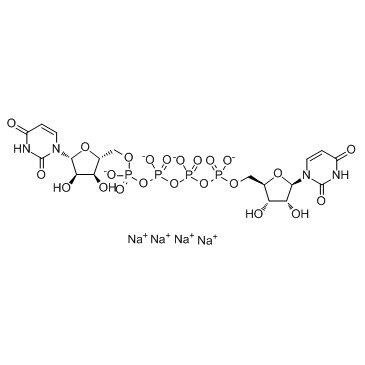Diquafosol tetrasodium (INS365) (Synonyms: INS365, KPY 998) |
| Catalog No.GC31664 |
Diquafosol tetrasodium (INS365) is a P2Y2 receptor agonist that stimulates fluid and mucin secretion on the ocular surface, as a topical treatment of dry eye disease.
Products are for research use only. Not for human use. We do not sell to patients.

Cas No.: 211427-08-6
Sample solution is provided at 25 µL, 10mM.
Diquafosol tetrasodium is a P2Y2 receptor agonist that stimulates fluid and mucin secretion on the ocular surface, as a topical treatment of dry eye disease.
Cell viability significantly decreased after treatment with 30% diluted diquafosol for 1 hour and 6 hours after treatment with 10% and 20% diluted diquafosol. Twenty-four hours after wounding monolayers, 3% diquafosol, and 0.3% HCECs exhibits significantly more wound healing than the control[1].
In a rat dry eye model, the P2Y2 agonist diquafosol tetrasodium is found to improve surface health, based on increases in tear fluid secretion, corneal epithelial resistance, and release of glycoprotein-containing moieties from goblet cells. Beginning at 2 weeks and continuing for an additional 2 weeks, maximal declines in dye penetrance of approximately 50% occurred with doses of diquafosol tetrasodium as low as 1%[2]. INS365 significantly suppresses corneal damage at concentrations of more than 0.1% w/v[3].
[1]. Lee JH, et al. Comparison of cytotoxicities and wound healing effects of diquafosol tetrasodium and hyaluronic acid on human corneal epithelial cells. Korean J Physiol Pharmacol. 2017 Mar;21(2):189-195. [2]. Fujihara T, et al. Improvement of corneal barrier function by the P2Y(2) agonist INS365 in a rat dry eye model. Invest Ophthalmol Vis Sci. 2001 Jan;42(1):96-100. [3]. Fujihara T, et al. INS365 suppresses loss of corneal epithelial integrity by secretion of mucin-like glycoprotein in a rabbit short-term dry eye model. J Ocul Pharmacol Ther. 2002 Aug;18(4):363-70.
Average Rating: 5 (Based on Reviews and 26 reference(s) in Google Scholar.)
GLPBIO products are for RESEARCH USE ONLY. Please make sure your review or question is research based.
Required fields are marked with *




















